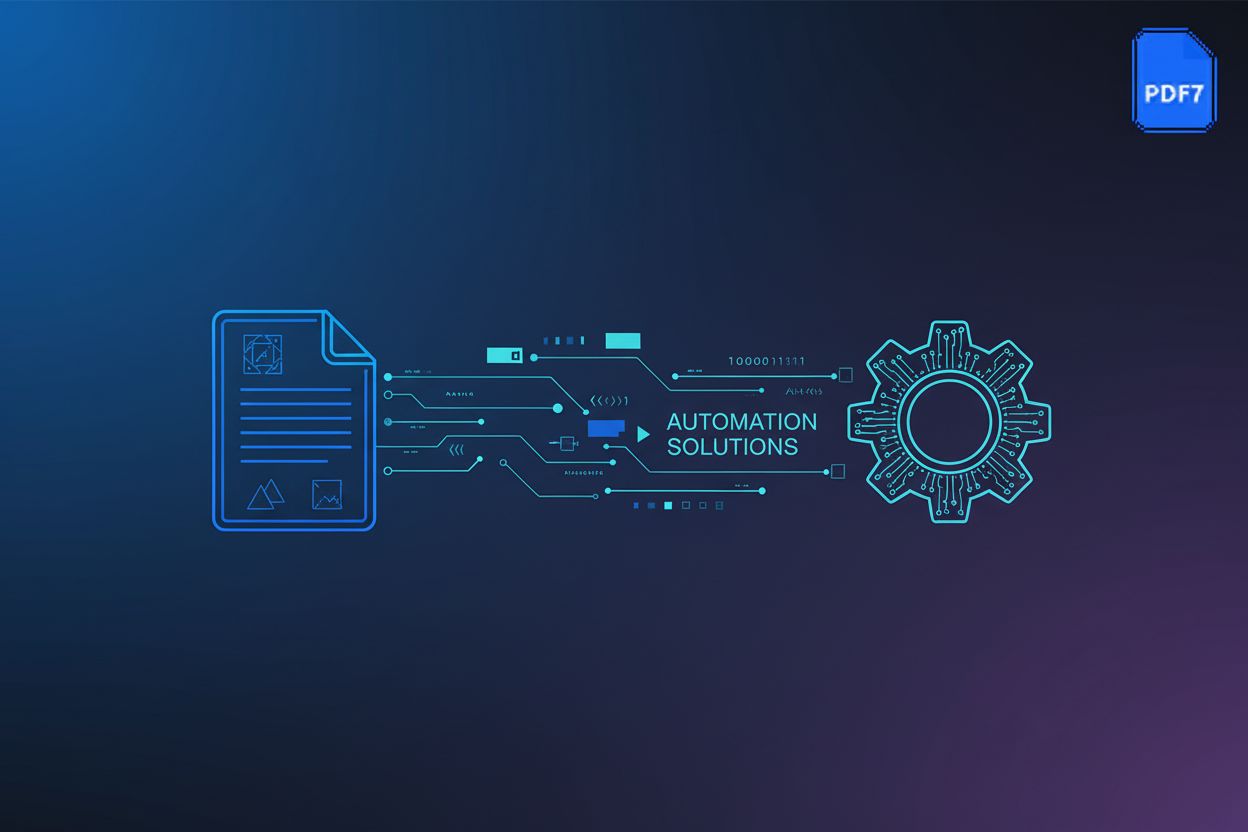Creating an Intelligent Document Processing Workflow
TL;DR
Understanding Intelligent Document Processing (IDP)
Okay, so you've probably dealt with mountains of documents at some point, right? Imagine if a robot could handle all that boring stuff for you, but, like, a smart robot. That's basically what Intelligent Document Processing (idp) is all about.
At its core, IDP is like the souped-up version of regular document processing. It uses a combo of tech – we're talking Optical Character Recognition (OCR) to "read" documents, artificial intelligence (ai) to understand them, and automation to, well, automate the whole shebang.
- Think of invoice processing. Instead of someone manually typing in all those numbers and dates, IDP can extract the data automatically, verify it against purchase orders, and even flag any discrepancies. (Intelligent Document Processing (IDP) - DocuWare) This is huge for accounts payable automation, saving companies tons of time and money.
- Or, consider forms. You know, those things nobody likes filling out? IDP can pull data from forms – whether they're handwritten or typed – and automatically populate databases. (What is Intelligent Document Processing? - IDP Explained) This is a game-changer for industries like healthcare, where there's a never-ending stream of patient forms.
- And don't forget about contracts! IDP can analyze contracts for key terms, clauses, and compliance issues, making contract management way less painful. (Automating Contract Management and the Role of IDP)
IDP isn't just about speed, though; it's about accuracy too. ai-powered systems can learn and improve over time, reducing errors and ensuring data integrity. That's pretty crucial, especially when you're dealing with sensitive information.
So, how does this all work in practice? Well, let's move on to some real-world examples to get a clearer picture.
Key Components of an IDP Workflow
Did you know that some documents go through, like, ten different systems before they're even processed? Crazy, right? That's why understanding the key components of an Intelligent Document Processing (IDP) workflow is super important. Let's break it down.
First up, we got Optical Character Recognition (OCR). Think of it as the eyes of the IDP system.
- OCR technology is what allows the system to "read" and convert scanned documents or images into machine-readable text. It's not perfect, though; the accuracy really depends on the quality of the document. Blurry scans? Forget about it. Choosing the correct OCR engine is very important. The type of OCR engine you choose will affect the accuracy and language support, and it's worth considering factors like its ability to handle handwritten text or specific document types.
- Oh, and preprocessing is a thing too. You might need to clean up the image (deskew, despeckle) before running OCR to get better results.
Then there's data extraction and classification. This is where the real magic happens.
- ai steps in to identify and pull out the relevant data fields from the document. Think names, dates, amounts – whatever you need. There's different techniques, too.
- Template-based extraction works well for structured documents like invoices, where the fields are always in the same place. Free-form extraction is needed for unstructured documents, like contracts. Other techniques include rule-based extraction, which uses predefined rules, and machine learning-based extraction, which learns from data to identify patterns.
- Document classification is also crucial; it's how the system knows what type of document it's dealing with (invoice, contract, form, etc.) so it can route it to the right place for processing.
Getting all that data out is great, but what about making sure it's correct? Next up is data validation and verification, which we'll cover as part of building your workflow.
Building Your IDP Workflow: A Step-by-Step Guide
Okay, so you've got your idp tools picked out – now what? It's time to actually design how your workflow should work. Trust me; this is where you make or break the whole operation.
Think of it like planning a road trip. You wouldn't just jump in the car and hope for the best, right? You'd map out your route, figure out where you're stopping, and maybe even pack a snack or two. Designing your workflow is kinda the same thing! Here's what you should do:
Visualize the process. Start by literally drawing out the steps a document takes, from the moment it enters your system to when the data is where it needs to be. Think of it like a flowchart.
Configure extraction rules: This is where you get specific about what data you're pulling from each document type. You can typically do this using a visual interface, defining patterns with regular expressions, or by leveraging machine learning models to learn extraction. For invoices, its invoice number, date, total amount, supplier. For medical claims, it's patient name, date of service, procedure codes, diagnosis. You get the idea.
Set up validation checks. ai isn't perfect, and sometimes it misreads things. Set up rules to automatically flag data that looks off. For example, if an invoice total is unusually high, have the system send it for manual review.
Define routing. Where does the document go after extraction and validation? Does it need approval from a manager? Does it automatically update a database? Map this out!
Let's say you're a bank processing loan applications. Your workflow might look like this: document received > OCR > extract applicant name, address, income, credit score > validate credit score against minimum requirement > if approved, route to underwriter; if not, send rejection letter. Simple, right? Or, consider a retail company automating its vendor invoice processing. They might use idp to extract invoice data, match it against purchase orders, and automatically approve payment if everything lines up. If there's a discrepancy, it gets flagged for review.
Designing your workflow is like building the engine that drives your entire intelligent document processing system. Get it right, and you'll see massive gains in efficiency and accuracy.
Next up, we'll talk about actually implementing and testing this workflow – because theory is great, but real-world performance is what really matters.
Integrating AI and Machine Learning for Enhanced IDP
Integrating ai and machine learning is where idp really takes off – it's like giving your document processing system a brain and the ability to learn. Seriously, it's a game changer.
So, how does ai actually help? Well, it's all about understanding the content of the documents, not just recognizing the words.
- Natural Language Processing (nlp) is key here. nlp allows the system to "read" and understand the text like a human. It can identify key phrases, understand the context, and even detect sentiment. For example, in analyzing customer feedback forms, sentiment analysis can help identify whether feedback is positive or negative. This is huge for things like contract analysis, where you need to understand the meaning of the clauses, not just the words used.
- Machine learning (ml) improves data extraction accuracy. Instead of relying on rigid templates, ml models can learn to identify data fields even if they're in slightly different places on different documents. Think about invoices – sometimes the invoice number is on the top left, sometimes it's on the top right. ml can handle that.
- ai also automates document classification and routing. Remember how we talked about classifying documents? ai can do it automatically, based on the content of the document. This means no more manual sorting! The system can automatically route invoices to accounts payable, contracts to legal, and so on.
Imagine a retail company using ai-powered idp to process customer feedback forms. nlp can analyze the feedback to identify common complaints or suggestions, and automatically route them to the appropriate department for action. Or think about a healthcare provider using ml to extract key information from patient records, like diagnoses, medications, and allergies. This can help improve patient care and reduce medical errors.
There's a bunch of different ml models you can use for idp, each with it's own strengths and weaknesses. Deep learning and neural networks are popular because they're really good at learning complex patterns. You can train custom models for specific document types, or use pre-trained models for common tasks like named entity recognition (ner). Named entity recognition (NER) is a technique that identifies and categorizes key entities in text, such as names of people, organizations, locations, and dates. For example, in a contract, NER can quickly pull out all the parties involved and their addresses.
The integration of AI and machine learning significantly enhances IDP's accuracy and efficiency, reducing manual data entry, automating exception handling, and enabling continuous adaptation to new document types.
Now, let's talk about how to make sure your idp system is actually secure.
Best Practices for Optimizing Your IDP Workflow
Okay, so you've got this fancy idp system humming along – but how do you make sure it's actually working well, and not just creating new problems? Turns out, a few tweaks can make a HUGE difference.
First things first: garbage in, garbage out, right? If your documents are a mess to begin with, your idp system is gonna' struggle, and you'll end up with bad data.
- High-quality scans and images are essential. Blurry images or crooked scans can throw off OCR and data extraction. Make sure you're using good scanners and that people know how to use 'em.
- Cleaning up documents beforehand can work wonders. Think deskewing, despeckling, and removing any unnecessary marks. Some idp platforms have built-in tools for this, or you can use separate image editing software like Adobe Photoshop or GIMP.
- Standardizing document formats is a big win. If you always get invoices in the same format, for example, it's way easier to train your idp system to extract the right data.
Data security – can't skip this part. you're dealing with sensitive information, so you have to make sure it's protected.
- Implement strong security measures. We're talking encryption, access controls, and regular security audits. Don't leave the back door open for hackers!
- Compliance with data privacy regulations is non-negotiable. GDPR, hipaa – you name it. Make sure your idp system is compliant with all the relevant regulations. This means handling data responsibly, ensuring proper consent, and having mechanisms for data access and deletion.
- Establish data retention policies. How long do you need to keep the data? And how are you going to securely dispose of it when you're done?
Don't just set it and forget it. You need to keep an eye on your idp system to make sure it's performing well and adapt to changing needs.
- Track key performance indicators (kpis). Things like accuracy, processing time, and cost savings. For accuracy, aim for 95% or higher. For processing time, try to reduce the average time by 20%. For cost savings, target a 15% reduction in manual processing costs. If your accuracy starts to dip, something's wrong.
- Identify bottlenecks and areas for optimization. Common bottlenecks include slow OCR processing, high error rates on specific document types, or lengthy manual review queues. For optimization, consider strategies like improving OCR engine settings, refining extraction rules, or implementing automated quality checks.
- Regularly review and update the workflow. Your business is constantly evolving, and your idp system needs to evolve with it.
So, with these best practices in mind, you’re well on your way to having a super efficient and effective idp workflow. Now, let's look into how to keep it all running smoothly with monitoring and continuous improvement.
The Future of Intelligent Document Processing
Bet you didn't think document processing could be exciting, huh? Well, hold on to your hats because the future of idp is looking pretty wild, with ai and machine learning leading the charge.
- Expect to see way more advanced ai that understands documents contextually, not just recognizing words. This means better accuracy and less need for manual intervention – which is always a win.
- Look out for deeper integration with robotic process automation (rpa). Imagine robots handling the repetitive tasks after the documents are processed. Think automatically updating databases or triggering workflows, all without human intervention.
- And don't sleep on cloud-based idp solutions. They're becoming more popular because they're scalable, flexible, and often more cost-effective than on-premise solutions. They offer scalability through on-demand resource allocation, flexibility with remote access from anywhere, and cost-effectiveness by avoiding upfront hardware investment and maintenance.
So, how do you get ready for all this? Start investing in scalable solutions, train your team to work alongside ai, and, most importantly, embrace change. The future of document automation is here, and it's pretty darn smart.









